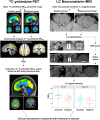Noradrenergic alterations in Parkinson's disease: a combined 11C-yohimbine PET/neuromelanin MRI study
- PMID: 37787503
- PMCID: PMC10994534
- DOI: 10.1093/brain/awad338
Noradrenergic alterations in Parkinson's disease: a combined 11C-yohimbine PET/neuromelanin MRI study
Abstract
Degeneration of the noradrenergic system is now considered a pathological hallmark of Parkinson's disease, but little is known about its consequences in terms of parkinsonian manifestations. Here, we evaluated two aspects of the noradrenergic system using multimodal in vivo imaging in patients with Parkinson's disease and healthy controls: the pigmented cell bodies of the locus coeruleus with neuromelanin sensitive MRI; and the density of α2-adrenergic receptors (ARs) with PET using 11C-yohimbine. Thirty patients with Parkinson's disease and 30 age- and sex-matched healthy control subjects were included. The characteristics of the patients' symptoms were assessed using the Movement Disorder Society Unified Parkinson's Disease Rating Scale (MDS-UPDRS). Patients showed reduced neuromelanin signal intensity in the locus coeruleus compared with controls and diminished 11C-yohimbine binding in widespread cortical regions, including the motor cortex, as well as in the insula, thalamus and putamen. Clinically, locus coeruleus neuronal loss was correlated with motor (bradykinesia, motor fluctuations, tremor) and non-motor (fatigue, apathy, constipation) symptoms. A reduction of α2-AR availability in the thalamus was associated with tremor, while a reduction in the putamen, the insula and the superior temporal gyrus was associated with anxiety. These results highlight a multifaceted alteration of the noradrenergic system in Parkinson's disease since locus coeruleus and α2-AR degeneration were found to be partly uncoupled. These findings raise important issues about noradrenergic dysfunction that may encourage the search for new drugs targeting this system, including α2-ARs, for the treatment of Parkinson's disease.
Keywords: PET/MRI; Parkinson’s disease; locus coeruleus; noradrenaline; α2-adrenergic receptors.
© The Author(s) 2023. Published by Oxford University Press on behalf of the Guarantors of Brain.
Conflict of interest statement
The authors report no competing interests.
Figures


References
-
- Politis M, Wu K, Loane C, et al. Depressive symptoms in PD correlate with higher 5-HTT binding in raphe and limbic structures. Neurology. 2010;75:1920–1927. - PubMed
-
- Sommerauer M, Fedorova TD, Hansen AK, et al. Evaluation of the noradrenergic system in Parkinson’s disease: An 11C-MeNER PET and neuromelanin MRI study. Brain. 2018;141:496–504. - PubMed
-
- Maillet A, Krack P, Lhommée E, et al. The prominent role of serotonergic degeneration in apathy, anxiety and depression in de novo Parkinson’s disease. Brain. 2016;139(Pt 9):2486–2502. - PubMed
-
- Malatt C, Tagliati M. The role of the locus coeruleus/norepinephrine system in the pathogenesis of neurodegenerative disorders: An update. Curr Opin Neurol. 2022;35:220–229. - PubMed
Publication types
MeSH terms
Substances
Grants and funding
LinkOut - more resources
Full Text Sources
Medical
Research Materials
Miscellaneous

